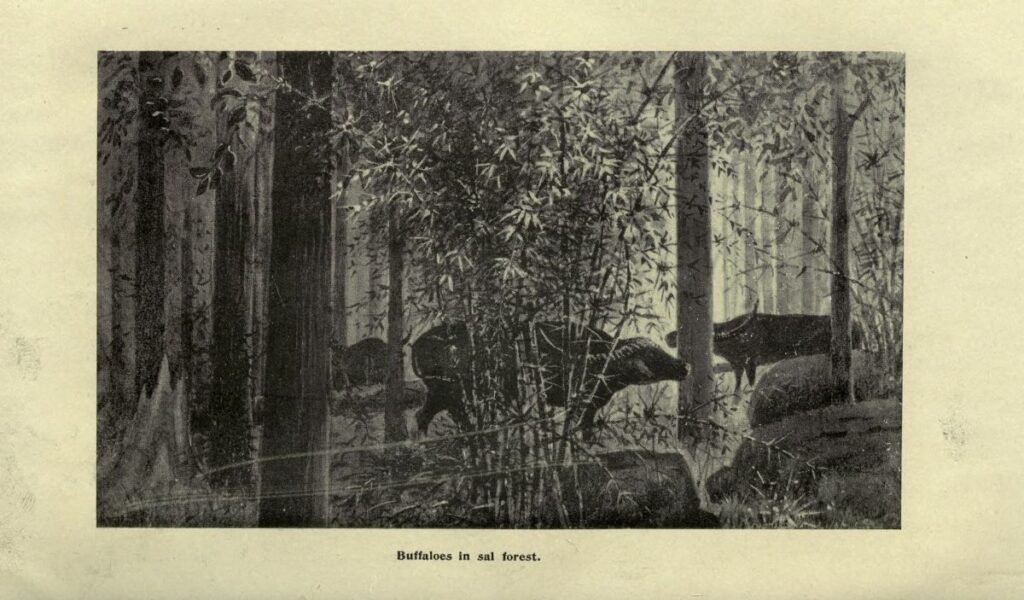When we think of charismatic mammals of the central Indian forests, we tend to think of tigers, leopards, dholes, barasinghas, and gaurs. With the recent return of elephants to central India, some would add these pachyderm to the list as well.

Image Credit: “Buffaloes in Sal Forest”, a sketch by Captain A.I.R. Glasfurd from his book “Leaves from an Indian Jungle” published in 1903.
But what about wild buffaloes? Most of us associate wild buffaloes with the fauna of north-east India. Large buffalo herds roaming the grasslands of Kaziranga and Manas tiger reserves in Assam immediately roll into our imaginations. But did you know that, historically, large tracts of the Sal forests of peninsular India were also home to wild buffaloes, and that they once were an integral part of the faunal make up of this landscape?
Once distributed across present day eastern Madhya Pradesh, north-eastern Maharashtra, Chhattisgarh, Odisha, northern Telangana, northern Andhra Pradesh, and parts of Jharkhand, these bovines were ubiquitous. Large herds of more than 100 heads were a rather common sight in Central India. But that was then.
Today their entire population survives in a single landscape – Chhattisgarh’s Indravati tiger reserve and the adjoining Kopela-Kolamarka forests across the border in Maharashtra’s Gadchiroli district. These forests also happen to be severely afflicted by armed left wing insurgency. Consequently, few outsiders can claim to have seen these shy bovine. Moreover, this has also made it difficult to arrive at reliable population estimates. However, it is believed that there may be anywhere between 40-80 animals, divided into a few small herds, that oscillate between Indravati Tiger Reserve and Kolamarka Wildlife Sanctuary.
few outsiders can claim to have seen these shy bovine in the recent decades. Moreover, this has also made it difficult to arrive at reliable population estimates. However, it is believed that there may be anywhere between 40-80 animals, divided into a few small herds, that + pic.twitter.com/VzbipkIpTg
— Wildlife Conservation Trust (India) (@WCT_India) August 22, 2024
What makes the Central Indian wild buffaloes even more special is the fact that these are widely considered to have undergone little to no genetic dilution compared to their brethren in Assam. The latter are believed to have suffered some genetic dilution due to cross-breeding with domestic buffaloes.
While there have been no concrete conservation interventions for these buffaloes due to their inaccessibility, a recent proposal floated by Maharashtra aims to begin captive conservation breeding of these buffaloes by capturing some individuals from Kolamarka.
About the Author: Raza Kazmi is a conservationist, wildlife historian, storyteller, and researcher. He is a Conservation Communicator at WCT and writes in both English and Hindi languages. His writings appear in national newspapers, online media houses, magazines and journals, and various edited anthologies. A recipient of the New India Foundation Fellowship for 2021, he is currently writing a book tentatively titled ‘To Whom Does the Forest Belong?: The Fate of Green in the Land of Red’.
Disclaimer: The author is associated with Wildlife Conservation Trust. The views and opinions expressed in the article are his own and do not necessarily reflect the views and opinions of Wildlife Conservation Trust.
Your donations support our on-ground operations, helping us meet our conservation goals.
Related Links
- Consultation on Tiger Conservation in the Central Indian Landscape
- Tiger Matters – A WCT-USAID Conservation Initiative
- Camera Trapping Outside Protected Areas
- Whose Right of Way?
- Tiger Matters – A Documentary on our 360 Degree Approach to Conservation
